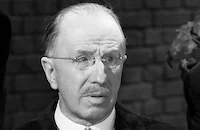Dangerously Yours
Cast & Crew
Frank Tuttle
Warner Baxter
Miriam Jordan
Herbert Mundin
Florence Eldridge
Florence Roberts
Film Details
Technical Specs

Synopsis
At the palatial Long Island home of the elderly Mrs. Lathem, one of her guests, playboy Theodore Brill, asks his friend, Andrew Burke, for the use of his yacht to entertain Claire Roberts, with whom he has begun a mild flirtation. Burke, who has come to steal Mrs. Lathem's diamond necklace, agrees, but his interest in Claire is now aroused. He enters Claire's room with the excuse that he was looking for Brill's room and gets a peek at her in the mirror in a revealing stage of undress. Claire, who earlier ordered her maid Esther to carry on a flirtation with Burke's lascivious butler Grove to learn more about Burke, tells Esther that she hopes Burke's entrance was not really a mistake. After Burke and Claire indulge in a silent flirtation during dinner, he invites her to sail with him the next day. Burke is upset when he learns from a jealous mutual acquaintance, Jo Horton, that after Claire's father, a banker, committed suicide and left her with virtually nothing, she took up with George Carr, a wealthy, boring friend of her father who offered to "look after" her. Mrs. Lathem is carried to her room after having become intoxicated. Burke then takes the necklace from where she left it, but when he notices that Claire is watching, he puts it into Mrs. Lathem's safe. The next night, during a séance, as the lights are out, Mrs. Lathem cries that her necklace has been stolen. The police and insurance detectives investigate, but find no clues, so the guests are allowed to retire. Burke then finds Claire packing. She says that she knows he took the necklace and tells him she now plans to "sell out" to Carr. Burke invites her to join him on a trip around the world with the money he will get from the robbery and confesses that he loves her. She convinces him to go with her to New York instead, and after he reveals that he hid the necklace in a slit in the lining of Mrs. Lathem's wrap, she retrieves it for him. Burke then overhears Claire on the telephone arrange to meet the police at Grand Central station and realizes that she is an insurance company agent. He and Grove abduct her and take her to the yacht. To keep her from swimming to shore, Burke, after a brawl with her, attaches a chain connected to an anchor to her leg. A week later, when Claire tries to wave and yell to a passing motor boat, Burke kisses her to force her to stop. Inside her cabin, he kisses her again and confesses that he still loves her. She kisses him passionately, but objects when he tells her of his plan to steal Mrs. Lathem's pearls. He explains that he enjoys stealing and living dangerously, and berates her for putting more importance in what he calls her "middle class morality" than in him. After vowing to fight him, Claire saws off the chain and escapes from the boat. She swims to shore and goes to a police station, but hesitates reporting the man she loves. The police, however, hold her for being Burke's accomplice, and Burke, who has followed her, sees and listens sympathetically at the door to the station. After Claire is released because of Carr's influence, another séance is held. Claire thinks that Burke is there to steal the pearls; however, after the lights are turned off, he replaces the necklace in Mrs. Lathem's wrap. Despite his sardonic nature, Grove expresses no disapproval in Burke's decision to give back the necklace for Claire.

Director
Frank Tuttle
Cast

Warner Baxter

Miriam Jordan

Herbert Mundin

Florence Eldridge
Florence Roberts

William Davidson

Arthur Hoyt

Mischa Auer

Nella Walker
Tyrell Davis
Edmund Burns
Robert Greig
Crew
Don Anderson
Paul Hervey Fox
Percy Ikerd
Horace Jackson
Rita Kaufman
Luis Molina
Max Parker
Albert W. Protzman
Al Rockett
Harold Schuster
John Seitz
John Van Wormer

Film Details
Technical Specs

Quotes
Trivia
Notes
The opening credits were missing from the print viewed. According to information in the Twentieth Century-Fox Produced Scripts Collection at the UCLA Theater Arts Library, the source of the story was actually an unpublished novel by Eric Noel, the professional name of Paul Hervey Fox. According to information in the MPAA/PCA Collection at the AMPAS Library, in October 1935, Twentieth Century-Fox withdrew their application for PCA certification at the request of the PCA. The 1937 Twentieth Century-Fox film of the same title (see below) was not a remake of this film.












